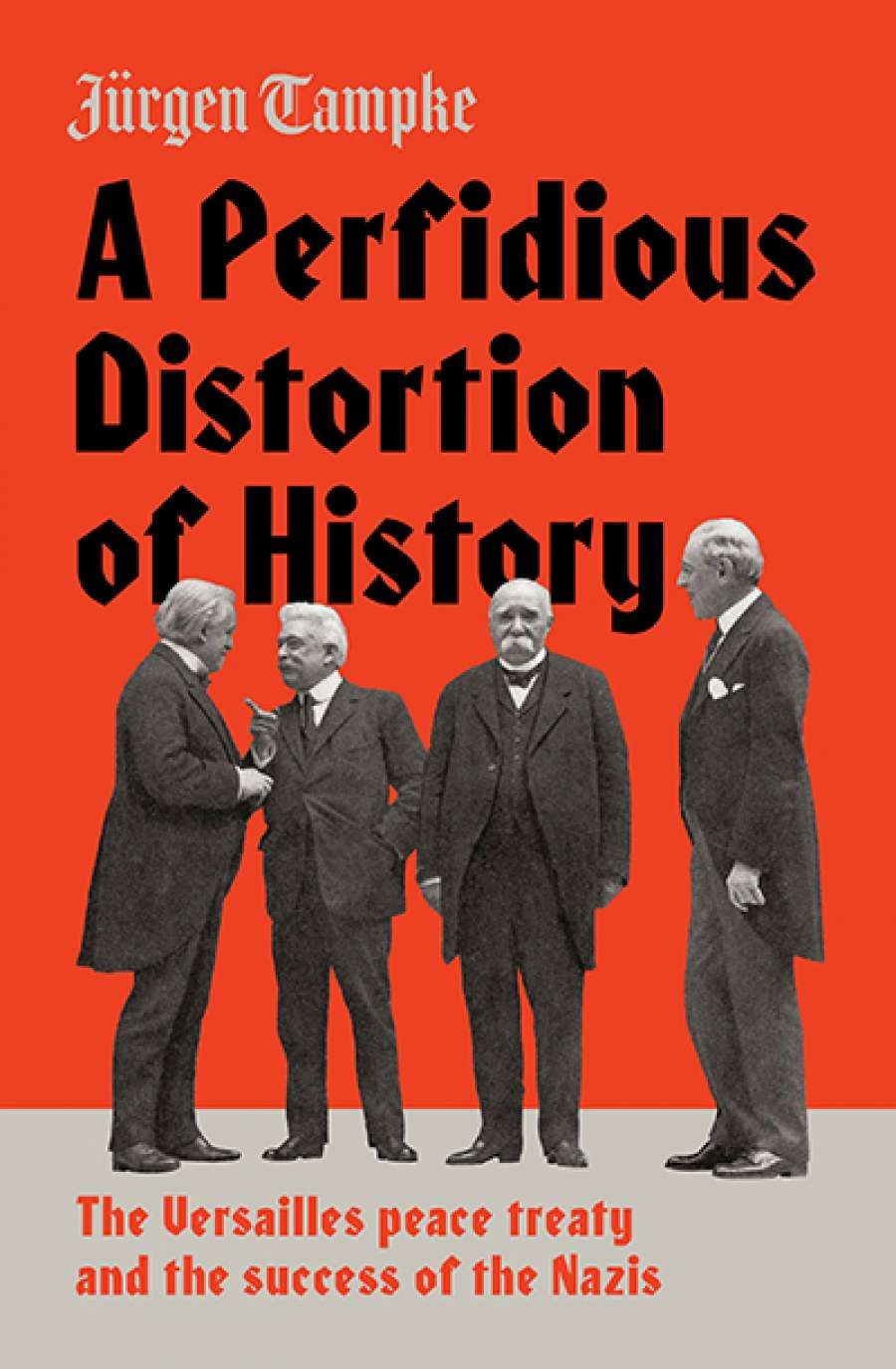
- Free Article: No
- Contents Category: History
- Custom Article Title: Miriam Cosic reviews 'A Perfidious Distortion of History: The Versailles Peace Treaty and the success of the Nazis' by Jürgen Tampke
- Book 1 Title: A Perfidious Distortion of History
- Book 1 Subtitle: The Versailles Peace Treaty and the success of the Nazis
- Book 1 Biblio: Scribe, $45 hb, 325 pp, 978192521944
French economist Étienne Mantoux’s World War II monograph, The Carthaginian Peace: Or, the economic consequences of Mr. Keynes (1946), was far less widely read, but contained a step-by-step rebuttal of the supposed effects of the Versailles Treaty. In it, he compared the expected and reported effects on, for example, German industrial output through the 1920s and 1930s and demonstrated how quickly the country recovered enough to power the terrible revanchism that ensued.
Jürgen Tampke’s compelling new book, A Perfidious Distortion of History, revisits Mantoux’s territory, aided by the later release of documents and late twentieth-century scholarship that endorsed much of the Frenchman’s claims and added even more ammunition. Tampke carefully steps through the articles of the Versailles Treaty, before going on to show how, while they fuelled popular anger in Germany, they remained largely unmet. He canvases territorial and population losses in the postwar settlement, for example, coming to the conclusion, with historian Robert Boyce, that they were a fraction of early claims. What’s more, once adjustments are made for the resettlement of German and non-German peoples in the aftermath of the war, the German population loss comes to a fifth of the ten per cent claimed.
Tampke tracks the fortunes of the German armaments industry even more exhaustively, showing how they were able to transfer production to Switzerland, the Netherlands, and Sweden, even while the Allies were satisfied that disarmament protocols were being met. Even within Germany, manufacturers managed to evade control, and the evasion seemed well enough known to everyone but the treaty supervisors. ‘Rheinmetall, for example, produced artillery under the guise of railway carriages. Factories that had previously manufactured tanks now fabricated inordinately large tractors,’ Tampke writes. ‘The joke was told in Berlin cabarets of the worker who smuggled parts out of his pram factory for his newborn, only to find when he put them together that he had assembled a machine gun.’
 Mass demonstration in front of the Reichstag against the Treaty of Versailles (Bildarchiv Preußischer Kulturbesitz, via Wikimedia Commons)
Mass demonstration in front of the Reichstag against the Treaty of Versailles (Bildarchiv Preußischer Kulturbesitz, via Wikimedia Commons)
Tampke’s book is not just about economics. In it, he traces the postwar political manoeuverings, not only of Germany but also of the Allies, who were more ineffectual than they, or history, believed. Not only did they not see the machinations of the Germans – including engineering the hyperinflation that heavily discounted their reparation payments, which they had already negotiated down from an initial minimal offer of 100 billion goldmarks and the reconstruction of France and Belgium, to a more modest, and even then unfulfilled, fifty billion goldmarks – but they negotiated with one eye on their own domestic audience.
On the political side, the Allies’ attempt to drag Germany kicking into twentieth-century democracy was undone by powerful conservative forces. The German judiciary and the military, Tampke points out, were hotbeds of the old class system. The judiciary routinely handed out fearful punishments to poor and left-wing defendants, and light or non-existent sentences to right-wing and high-class defendants, including the rash of assassins who eliminated Weimar political figures such as the Foreign Minister Walther Rathenau. The military, led by aristocrats, smarted from a sense of unearned defeat. ‘On the 30 January 1933,’ Tampke writes, ‘the reactionary German political establishment brought Hitler into power. This was not the fault of the Versailles Peace Treaty.’
Tampke’s point of view is not a new one. Margaret MacMillan’s gripping book Paris 1919 (2002), makes a similar argument; Tampke acknowledges her influence, and that of others, on his work. Since then, more material has come to light, with continuing work on the archives of the former Warsaw Pact countries and a shift in biases and pieties as the two world wars recede into history.
 The delegations signing the Treaty of Versailles in the Hall of Mirrors
The delegations signing the Treaty of Versailles in the Hall of Mirrors
(US National Archives, via Wikimedia Commons)
Though born in Brandenburg himself, Tampke came to Australia as a young man. He completed his PhD in history at the Australian National University, before becoming an associate professor at the University of New South Wales, so this is a rare examination of the period from an Australian perspective.
A Perfidious Distortion of History, like its title, is polemical and blunt. Tampke doesn’t shy away from calling descriptions and interpretations ‘untrue’ and ‘unconvincing’, which is a breath of fresh air in the often excruciatingly diplomatic world of scholarship. He is also an engaging writer who manages to unravel and enliven the most detailed exploration of facts and figures. Caveat emptor, however. Tampke is a seductive advocate for his point of view, but not everyone will agree with it.


Comments powered by CComment